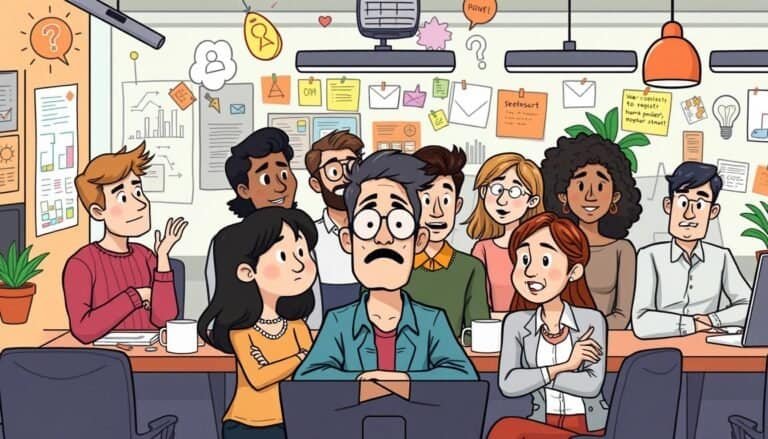Understanding Gestalt Principles of Perception
Have you ever seen shapes that suddenly form a complete picture in your mind? The Gestalt Principles of Perception explain this, showing how our brains turn parts into a whole. These ideas come from the German word for “shape” or “form.” They teach us that our brains make a detailed picture from different visual parts.
Kurt Koffka once said, “The whole is other than the sum of the parts.” This idea is key to understanding how we see the world. It’s not just about seeing things one by one, but how they work together.
Early psychologists like Max Wertheimer, Wolfgang Köhler, and Kurt Koffka found six main rules for how we see things together. These rules help us make sense of our world, from art to websites. They show us how we connect with the world around us.
Key Takeaways
- The six Gestalt principles explain how we interpret and organize visual stimuli.
- Max Wertheimer’s phi phenomenon shows how motion can be perceived through changing light patterns.
- The law of similarity and the law of proximity both define how we group visual elements.
- Gestalt psychology underscores that the collective whole is perceived differently than individual elements.
- Utilizing these principles can enhance user experience and improve design effectiveness.
Introduction to Gestalt Principles
Gestalt psychology looks at how humans see complex scenes as whole units, not just parts. It started in the early 1900s as a new way to understand the mind. Designers use these ideas to make things that connect with people.
The Gestalt design principles show how our eyes see patterns. They tell us that our brains link design elements together. For example, if things look the same, we see them as a group, even if they’re far apart. This helps web designers make sites easy to use and understand.
Using Gestalt principles makes designs clearer and easier to use. Designers learn about things like emergence and reification to make simple ideas clear. This way, design can be both beautiful and clear.
What are the Gestalt Principles?
The Gestalt Principles of Perception help us make sense of what we see. They came from Gestalt psychology in the early 1900s. Back then, psychologists looked at how we see things as a whole, not just the parts.
Definition and Historical Context
The word “Gestalt” means “shape” or “form” in German. These principles show how we naturally see patterns and shapes as complete things, not just pieces. Max Wertheimer, Kurt Koffka, and Wolfgang Köhler developed these ideas. They showed us how our brains tend to organize what we see into meaningful patterns.
Key Contributors to Gestalt Psychology
Max Wertheimer, an Austro-Hungarian psychologist, started the Gestalt movement. Kurt Koffka and Wolfgang Köhler also made big contributions. Together, they showed how our brains work to see the big picture, not just the details. Their work has changed how we think about psychology, design, and art.
| Key Contributor | Nationality | Major Contribution |
|---|---|---|
| Max Wertheimer | Austro-Hungarian | Foundation of Gestalt psychology; introduced key principles. |
| Kurt Koffka | German | Expanded on Gestalt theory; developed principles of perception. |
| Wolfgang Köhler | German | Investigated problem-solving and insight learning. |
Key Gestalt Principles of Perception
Designers need to know the key gestalt principles to make visuals engaging and easy to understand. These principles help organize visual elements and improve how people interact with them. The Law of Similarity, Law of Proximity, and Law of Closure are key to how we see things.
The Law of Similarity
The Law of Similarity says that things with the same color, shape, or size are seen as together. This makes it easier to group things in design. For example, matching buttons on a website can show they do the same thing, making it easier to use.
The Law of Proximity
Objects close to each other are seen as connected, says the Law of Proximity. This helps designers show how things are related. By putting things together, they make it easier to understand and use the information.
The Law of Closure
The Law of Closure is about seeing complete shapes even if parts are missing. Designers use this to make visuals more interesting. For example, a simple logo can suggest a complex idea by leaving some details out.
Application of the Figure-Ground Relationship
The figure-ground relationship is key to understanding how we see things. It helps us tell the main subject from the background. Using this in design makes things clearer and focuses our attention on important parts.
Understanding Figure and Ground in Design
In design, the figure-ground relationship shows how different parts work together visually. Designers use it to make sure elements are clear and communicate ideas well. A clear figure makes it easy to spot important parts, which is vital in graphic design and arranging things.
Importance in Visual Arts and Perception
The figure-ground is very important in visual arts. Artists use it to make their work more emotional. It makes the main subject stand out, making the art more engaging. Knowing how to use the figure-ground makes art more expressive and grabs attention.
Real-world Examples
Many real-life examples show how the figure-ground relationship works. For example, logos use it to make a lasting impression. Good logos make sure the main parts stand out against the background. This makes them easy to recognize.
In user interface (UI) design, clear differences between elements help users interact better and remember things. This shows how important visual perception is in our daily lives.
Understanding Closure Principle
Closure is key in how we see things, helping us fill in missing parts of images or designs. It’s part of understanding how our brains work when we see things that are not fully there. Designers use this idea to make their work clear and simple, even when they leave out some details.
How Closure Works in Visual Perception
Our brains naturally want to see complete shapes and patterns, even from broken images. This helps us make sense of what we see, even if it’s not all there. For example, logos use closure to send clear messages without showing everything.
Take the logos of PBS and Major League Baseball. They let us fill in the missing parts and see the shapes easily. Google Slides also uses closure to show what a button does without making it too busy.
Examples of Closure in Everyday Life
Designs in everyday life often use closure too. Website carousels show us there’s more to see, making us want to click. Apps like Headspace make it seem like everything is right there, which might stop us from looking further.
Designers must think about what they show and hint at what’s not shown. This way, they grab our attention by showing how we can see patterns and connections easily. Closure shows how our brains help us see more than what’s really there, making designs more engaging.
Exploring Proximity Principle
The proximity principle is key in design, showing how elements are visually connected. It helps designers make layouts that are clear and easy to understand. This principle says that things close together are seen as a group. This makes communication clear and reduces clutter.
Groupings in Design and Layout
Good groupings in design make things clear and easy to use. When elements are close together, they form groups in the viewer’s mind. This makes understanding faster. This idea is useful in many designs, like websites, ads, and printed materials.
- Menu items close together make using them easier.
- Buttons close together make moving around simpler.
- Visual groups create a clear order and focus user attention.
Proximity in User Experience
The proximity principle is crucial in making digital interactions better. Using it right can make interfaces clear and engaging. Designers should think about how elements connect with each other.
By placing important parts together, users can move through a site more easily. This careful planning leads to:
- Better understanding and happiness from users.
- Paths that are smoother, reducing frustration.
- Tasks that are quicker to finish.
The proximity principle is key in design, shaping how we interact and see things. By using it wisely, designers improve both the look and function of their work.
Examining Similarity Principle
The examining similarity principle shows how our brains group similar things together. This makes our visual experience clear. Designers use shape, color, and size to make things look connected.
Using the law of similarity makes it easier to see how different parts of a webpage relate. It helps users move around by linking similar items together. When links or buttons look alike, it’s easier to see what they do.
Here are ways designers use the similarity principle:
- Navigation Systems: Putting related links together makes it easy to find what you need.
- Content Differentiation: Using the same style for headings or layouts helps users tell content types apart.
- Calls to Action: Using color and shape to highlight actions makes them more noticeable.
This principle helps organize information and makes the user experience better. By using the similarity principle, designers can make designs that look good and work well. This makes users more engaged with digital products.
Implications of Gestalt Principles for Designers
Designers gain a lot from using Gestalt principles. These guidelines make designs better for users. They help in making it easier for people to use and enjoy content.
By knowing how people see visual elements, designers can make designs that are easy to use. This makes layouts simpler. It helps viewers see patterns and connections easily.
Enhancing User Experience
Designers use principles like the Law of Similarity and the Law of Proximity to guide users. For instance, using the same colors or shapes for links makes it easier for users to find their way around a website. This makes users more engaged and helps them remember information better.
Creating Visual Hierarchy
Creating a visual hierarchy is important with Gestalt principles. Designers use size, color, and layout to focus attention on key parts of a design. This makes sure information is easy to find and in order.
Using Gestalt principles well makes designs easier to see and connects users with the design better.







